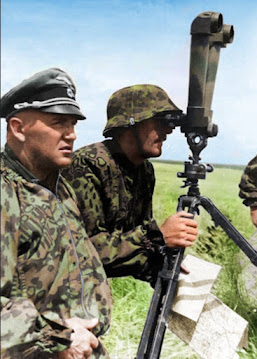The Nazi German forces were split into three army groups during the Barbarossa campaign, each with a specific objective. Army Group North was to head through the Baltic States of Latvia, Lithuania and Estonia and take Leningrad. Army Group South would attack into Ukraine towards Kiev and the Donbas industrial region. Between them, Army Group Centre's objective was Minsk, Smolensk and then Moscow itself. The Waffen-SS divisions were divided among the different army groups and placed under the command of the Wehrmacht. In the North, the SS-Division Totenkopf was operating with Generaloberst Erich Hoepner's 4th Panzer Group. In the center Reich was part of Generaloberst Heinz Guderian's 2nd Panzer Group. In the South Wiking and Leibstandarte were deployed alongside the tanks of Generaloberst Ewald von Kleist's 1st Panzer Group. The Germans got off to a good start, with the panzer groups quickly pushing towards their objectives and Russian forces falling apart in confusion. The armored columns advanced deep into Soviet territory with the Leibstandarte and Wiking impressing their Army counterparts with their aggression and skill in attack, and the Reich distinguished itself on numerous occasions. The soldiers of the Waffen-SS were living in a cruel remorseless world, forever removed from the ideological verbiage of the political SS. While the Waffen-SS divisions were fighting in the front line, behind the lines it was a different story. The 1st and 2nd SS-Infanterie-Brigades, formed from former SS concentration camp guards of the SS-Totenkopfverbände for service behind the front line and the SS-Kavallerie-Brigade created for occupation duties and anti-partisan operations moved into the Soviet Union behind the advancing armies. They and the paramilitary death squads of the Einsatzgruppen were assigned to the Reich Main Security Office (RSHA) and used for rear area security and policing, and were not under Army or Waffen-SS command. Left image: SS forward observers using periscope binoculars designed as stereoscopic rangefinders. According to the book Panzergrenadiere der 5. SS-Panzerdivision Wiking im Bild, the photo shows Generalstabsoffizier (Ia) of the Wiking SS-Sturmbannführer Günther Ecke during the opening days of Barbarossa. Günther Ecke was KIA on Aug. 6 1941, near the city of Smila. c. Bundesarchiv. Right image: tanker of the LSSAH scanning the horizon for the next target. Photo taken at the Kursk salient later on in the war by SS-KB Max Büschel. U.S. NARA.


This comment has been removed by a blog administrator.
ReplyDeleteWaffen-SS slaughtered innocent Soviet civilians in the millions. Most of their volunteers were criminals and traitors.
ReplyDeleteWhat a total lack of historical knowledge! Your parroting is mind boggling, but whatever Igors Augstmanis, revel in your ignorance.
DeleteIgors Augstmanis comment is nothing more than nonsense, as anyone with the slightest of knowledge of the Waffen-SS knows. The less people like Augstmanis know, the more confident they are :)
DeleteAbsolutely not true. Simply false.
DeleteYour understanding of history is sadly out of date. Please educate yourself.
DeleteThat’s one of the downsides of 21st century social media. Fools that know very little about anything have a voice. Let’s be candid here Igors Augstmanis. I doubt the veracity of your claim to be in any way a scholar of military history. I suspect the contrary is true. Perhaps you should do some more reading and studying the subject.
ReplyDeleteJust ignore comments of the like. Greetz from Copenhagen!
DeleteThe most fearsome fighting force to ever take to a battlefield. The Waffen SS need not apologize to anyone. A great many of them fought to the death with honor in the face of overwhelming odds.
ReplyDeleteGunther Ecke wears a standard SS camo smock with the lacing replaced by a zipper. I'm guessing that the alteration was made by the owner himself. The use of zippers on SS smocks were not common, but zippers were used by all branches of the German military. Great pic, thanks for sharing.
ReplyDelete